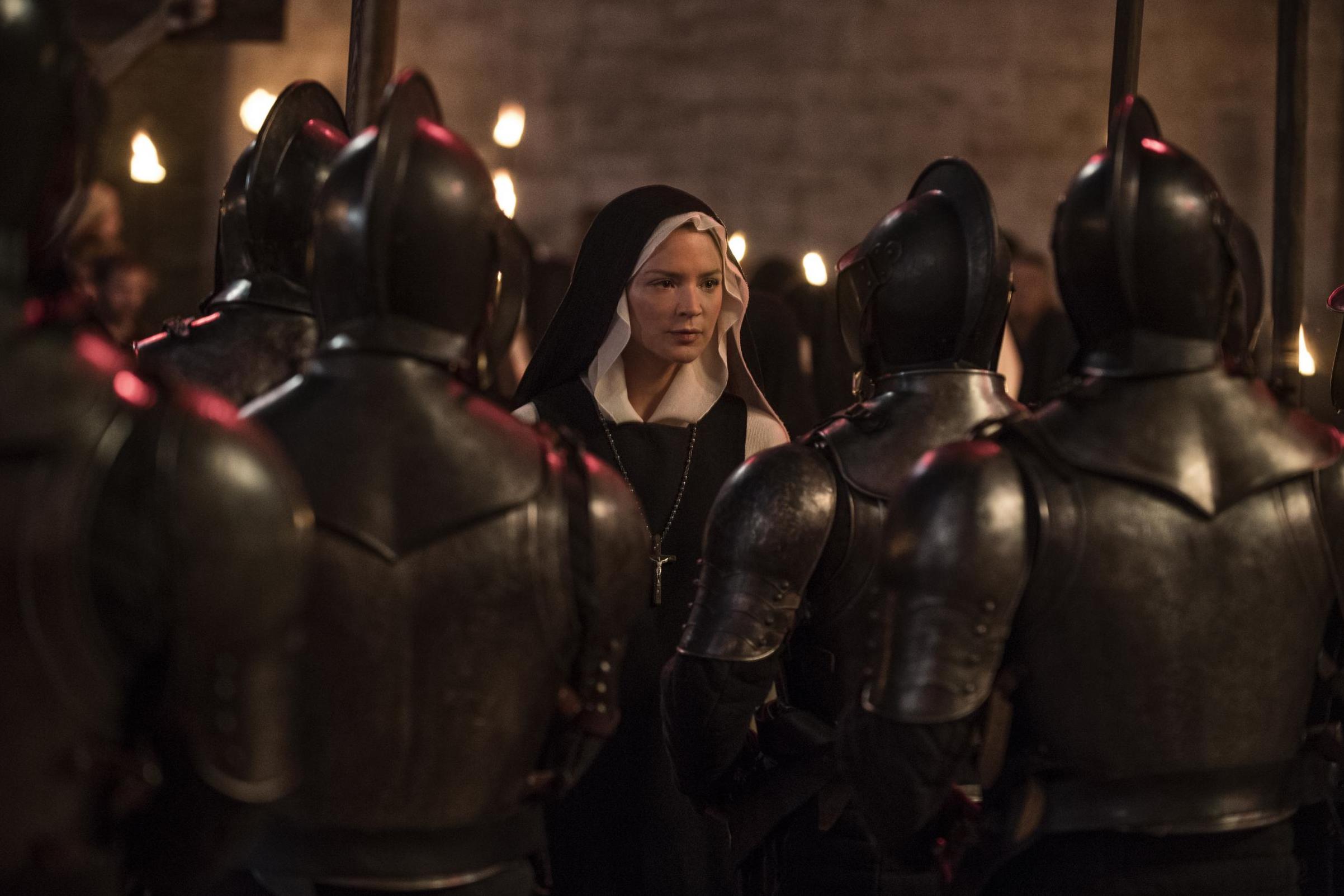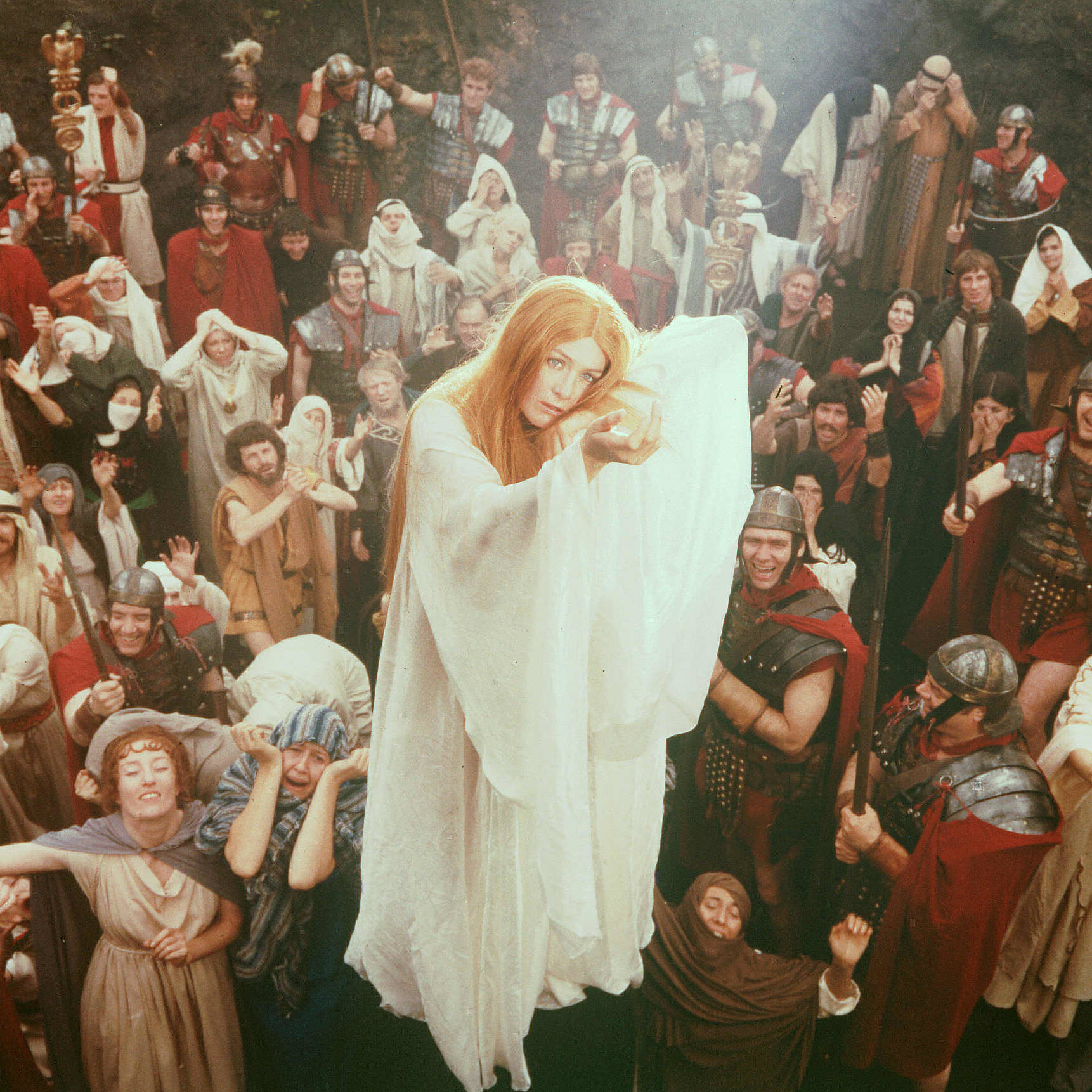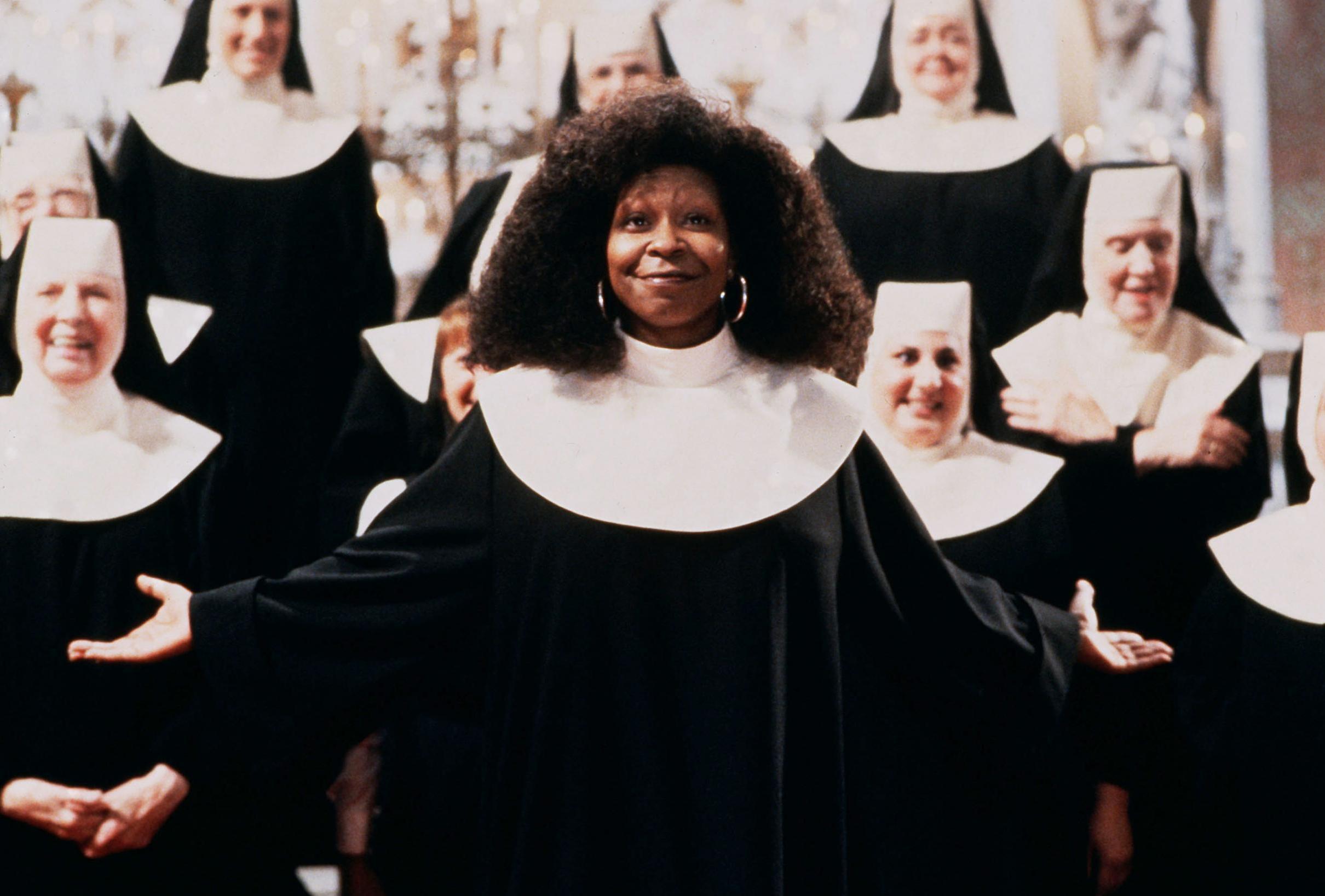Repression, erotic longing and sexual liaisons: Why filmmakers are always drawn to nuns
Paul Verhoeven’s lesbian nun drama ‘Benedetta’, which is due out later this year, follows in a long tradition of exploitation films in which the sexual desires of nuns are put in the spotlight, says Geoffrey Macnab

The teaser poster is typical Paul Verhoeven. A nun is shown in her white habit, the top of her face obscured, but she is wearing lipstick and her garment is loose enough for us to see half a nipple protruding. Benedetta, which is due out later this year, is already being marketed as if it’s Basic Instinct with crucifixes and wimples.
The film is adapted not from some salacious novel but from a book by a respected American academic. Professor Judith C Brown’s Immodest Acts: The Life of a Lesbian Nun in Renaissance Italy, published in 1986, is regarded as a groundbreaking study of one of the few chronicled cases of lesbianism in the Renaissance era.
Benedetta had entered a convent at the age of nine in 1599. In her early twenties, she began to have visions. In these visions, Brown writes, she was “pursued at night by handsome young men who wanted to kill her and who beat her all over with iron chains, swords, sticks and other weapons”. She also saw Jesus, developed stigmata, and was considered as a true mystic. Benedetta (played by Virginie Efira in Verhoeven’s upcoming film) was eventually elected abbess but that was before the ecclesiastical officials discovered her relationship with her special companion, Sister Bartolomea Crivelli, with whom she engaged in “the most immodest acts”.
Verhoeven’s new feature follows in a long tradition of exploitation films in which nuns’ erotic longings are foregrounded. Verhoeven, though, is also looking at Benedetta’s spiritual life. He is portraying her as a pioneering figure who chafed against the social and sexual constraints of her era. This promises to be far richer and more nuanced than most other recent films featuring nuns.
Nuns in movies are generally given a very bad rap. The most glamorous Hollywood stars have played nuns: Ingrid Bergman in The Bells of St Mary’s, Audrey Hepburn in The Nun’s Story, Meg Tilly and Anne Bancroft in Agnes of God, and Meryl Streep and Amy Adams in Doubt. But it is still hard to think of many films that have portrayed their lives in a positive fashion. They appear on screen much more frequently than might be imagined. There are more movies with nuns than there are with monks. You will see them pop up in horror films, in lurid historical dramas, and in several stories about brutal childhoods. They feature in musicals (notably, The Sound of Music) and in comedies.

It’s easy to dismiss all the softcore “nunsploitation” dramas about horny, sexually repressed sisters and mother superiors (The Nun and the Devil, Story of a Cloistered Nun and many, many others) as being sensationalist fantasies dreamt up by ageing male directors in dirty macs. In fact, such movies have some basis in historical fact. As Brown pointed out in Immodest Acts, “convents [in the Renaissance era] were notorious for their loose moral standards and for their sexual license, which is not surprising because they were less often the homes of women with a strong religious vocation than warehouses for the discarded women of middle-class and patrician families”.
Walerian Borowczyk’s Behind Convent Walls (1977), featuring several scenes of nuns pleasuring themselves with homemade sex toys, was actually inspired by a passage in Stendhal’s A Roman Journal. The Italian romp The Nun and the Devil (1973), which co-stars former Miss Great Britain winner Anne Heywood, may be described by Time Out’s reviewer as an exercise in “close-up goggling at nuns’ habits, and heavy breathing as stockings are unfurled and feet kissed”, but its story was taken from legitimate 16th century sources.
There was also a historical basis for the scenes of mass hysteria among the nuns found in Ken Russell’s The Devils (1971) and Jerzy Kawalerowicz’s Mother Joan of the Angels (1961). Both were inspired by the stories of demonic possession in Loudun, France, in 1634, written about in Aldous Huxley’s The Devils of Loudun and in John Whiting’s play The Devils.
“God freaks them out,” Russell said of the frenzied British response to The Devils, which starred Vanessa Redgrave as Sister Jeanne and Oliver Reed as priest Urban Grandier. The director saw his film as a “political statement … about corruption and mass brainwashing by church and state”. Others regarded its combination of religion, sex and violence as borderline blasphemous. Russell had to remove the “entire ‘Rape of Christ’ sequence in which a group of nuns cavort on a crucifix” before the British Board of Film Classification would even consider giving the film a certificate. The story about the Machiavellian scheming of Louis XIII and Cardinal Richelieu to undermine the political independence of the town of Loudun was completely forgotten. All anybody could concentrate on was Redgrave’s seamy fantasies about the priest and all those writhing nuns.
The nuns thrash around in Mother Joan too. This, though, is a far less overwrought affair than The Devils. The film is shot in black and white and its scenes of the women in their habits leaping around the church play like something out of a stylised Pina Bausch-style modern dance performance.
Nuns are the protagonists in one of the greatest and most exotic British films of the 1940s, Powell and Pressburger’s Black Narcissus (1947). Generally, nuns in European movies are confined to cold, damp, stone convents in forsaken corners of the cold, damp countryside. Here, though, they are in the Himalayas and the film is shot in harsh, glowing Technicolor. The passions are much the same as in the nunsploitation movies. This is a story about repression, longing, and sexual jealousy. Sister Clodagh (Deborah Kerr) has taken vows as she tries to run away from a broken romance. Sister Ruth (Kathleen Byron) doesn’t let her monastic lifestyle stop her from trying to seduce the strapping Mr Dean (David Farrar). The two women eventually have their own epic battle as Ruth tries to push Clodagh off a cliff. It’s torrid, expressionistic storytelling filmed with an operatic flamboyance.
If nuns are a source of erotic fascination for certain directors, they are also very popular in horror movies. They will often creep out of the shadows or appear behind characters’ shoulders. They’ll have grotesque smiles on their faces and streaks of blood running down their bony cheeks in lieu of more conventional make-up. You can find them in films like The Conjuring 2, malevolent presences who are called into action every time the audience needs an extra fright.
Men love to dress up in wimples. Eric Idle and Robbie Coltrane had an unlikely hit doing just that in Nuns on The Run (1990) in which they played gangsters hiding out in a nunnery.
Even more popular was Sister Act (1992) in which Whoopi Goldberg was a lounge singer placed in witness protection after seeing a gangland slaying. Her hideaway was a convent. She hated it there, living in among the “penguins” as she called them until she started leading the choir. Critics turned up their noses but the film was a phenomenon, yielding a sequel, a stage musical spin-off, and proving to the studio bosses just how popular nuns are on screen when some schmaltz and a few songs are added to the mix.
While some filmmakers use nuns to titillate or terrify viewers, others do so to express their disdain for Catholic hypocrisy. That was Pedro Almodovar’s intention in his early film, Dark Habits (1983), in which the nuns have names like Sister Snake and Sister Sewer Rat and are as interested in drugs, fashion and animal welfare as in conventional religion.
There have been several screen adaptations of Denis Diderot’s 18th-century novel The Nun, about a young woman locked away by her parents against her will in a convent. The most recent, directed by Guillaume Nicloux and co-starring Isabelle Huppert, was like a tough and austere prison drama with nuns instead of convicts.
When it comes to raising children or young adults, nuns are invariably monstrous figures. Think of Geraldine McEwan as the terrifying Sister Bridget in Peter Mullan’s Venice Golden Lion winner, The Magdalene Sisters (2002), a drama set in the notorious Magdalene asylums where orphans and unmarried pregnant women were sent to fester. They were made to work in the laundries and bullied relentlessly by the sisters.

In Stephen Frears’ Philomena, the nuns don’t just treat the young Philomena with wanton cruelty. They take her son away from her. Years later, they dissemble about what happened to him. In The Farrelly brothers’ otherwise only fitfully funny The Three Stooges (2012), Larry David has a very effective cameo as the aptly named Sister Mary-Mengele, the meanest, cruelest nun in the orphanage. She is a (slightly) caricatured version of all those other nuns in films whose sole purpose in life is making the children in their orphanages or schools as miserable as possible.
From the sour-faced Sister Mengele, it’s a long leap to the beautiful 19-year-old Polish nun played by Agata Trzebuchowska in Pawel Pawlikowski’s Oscar winning Ida (2013). Ida is instructed to go back into civilian life for one last time before taking her vows. She is naive and gentle, startled by what she encounters outside the convent walls and what she learns about her own past. Ida has a spiritual purity all too rare in films featuring nuns.
In Anne Fontaine’s downbeat drama The Innocents (2016), the nuns in a remote rural convent are traumatised after several are raped by Soviet soldiers. They have to cope with the intrusion of a brutal outside world into their secluded lives.
Filmmakers continue to throw nuns into their movies without paying much attention to their vocation or trying to understand what their daily lives are actually like. Next to Nazis, they’re the stock characters of choice in horror and exploitation movies. That’s why we have films like Nude Nuns with Big Guns (2010), a revenge drama involving drugs, motorbikes and plenty of gunfights. “An innocent nun was drugged, beaten and left for dead… she lost everything except her faith. Now she is going to show them that hell hath no fury like a nude nun with a big gun!” runs the marketing spiel for what is surely the nadir of the nunsploitation genre.
Contrast this with No Greater Love (2009), Michael Whyte’s painstaking and very respectful documentary about an order of Carmelite nuns in Notting Hill. The reality as Whyte shows is nothing like that shown in the other movies. The nuns exist in a world of calm, silence, prayer, and work. They take vows of poverty, chastity and obedience. They will only leave the monastery to visit the doctor or the dentist. This, one can safely predict, is not the kind of nun’s story that Verhoeven will be telling in his new movie Benedetta.
‘Benedetta’ is due to be released later this year
Join our commenting forum
Join thought-provoking conversations, follow other Independent readers and see their replies
Comments